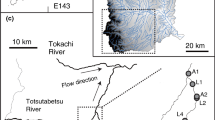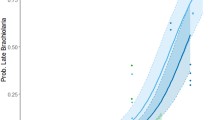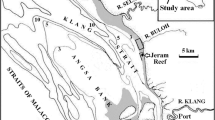Abstract
The population of Ephydra cinerea was studied during three summers when dissolved solids levels were about 130 g/l. All life stages are present year-round, but there is apparently some coordination of the initial pulse of adult emergence in June. There are probably 1–2 generations per year.
Eggs are deposited on the water surface; inputs to three locations were similar. Larvae successfully avoid the large benthic area covered by an anaerobic monimolimnion. They tend to immigrate from substrates where they grow relatively poorly, and to remain on substrates where they grow better. Consequently, larval densities are more than ten times higher on reef and shallow water mud substrates than on sand. This marked spatial specialization in the absence of substrate-specific predators or competitors illustrates the power of habitat quality by itself in determining spatial patterns of abundance in a lake.
Experiments showed larval growth on the reef was inversely related to density, and the lake as a whole produced relatively larger flies in a year when larval and pupal densities were relatively low. Yearly production by E. cinerea is roughly 50 g/m2, about 88% of which comes from reefs and shallow water mud areas covering only 18% of the bottom area.
Past studies indicate that blue-green algae dominate the lake's benthic flora when salt concentrations are high (due to low lake levels), and diatoms take over when salt concentrations are low. Fly abundance appears to be inversely related to salinity.
The lake's present high planktonic primary production is equal to that of eutrophic freshwater lakes, yet it has water clarity more characteristic of an oligotrophic lake. The high water clarity (which makes possible the high benthic production) probably depends on the absence of phytoplankters that can both tolerate the high salinity and avoid being eaten by Artemia salina. Continued dilution of the lake will probably upset this situation and result in reorganization of the lake's energy flow pattern.
Similar content being viewed by others
References
Adams, T. C. 1964. Salt migration to the northwest body of the Great Salt Lake, Utah. Science 143: 1027–1029.
Aldrich, J. M. 1912. The biology of some western species of the dipterous genus Ephydra. J. N. Y. Ent. Soc. 20: 77–79.
Bøggild, O. & Keiding, J. 1958. Competition in house fly larvae: experiments involving a DDT resistant and a susceptible strain. Oikos 9: 1–25.
Brinkhurst, R. O. 1974. The benthos of lakes. MacMillan, London. 190 pp.
Carozzi, A. V. 1962. Observations of algal biostromes inthe Great Salt Lake, Utah. J. Geol. 70: 246–252.
Charles, W. N., East, K., Brown, D., Gray, M. A., Murray, T. D. 1974. The production of larval chironomidae in the mud at Loch Leven, Kinross. Proc. R. Soc. EdinburghSer. B: 15: 241–258.
Collins, N. C. 1977. Ecological studies of terminal lakes-their relevance to problems in limnology and population biology, pp. 411–420. In Greer, D. C. [ed.]. Desertic terminal lakes. Utah Water Research Laboratory, Logan, Utah.
Collins, N. C. 1980. Using phenotypic responses to stress as predictors of natural environmental characteristics—an evaluation emphasizing the higher Diptera. Submitted to Ecology.
Daines, L. L. (printed in error as Daniels). 1917. On the flora of the Great Salt Lake. Am. Nat. 51: 499–506.
Davies, B. R. 1976. The dispersal of Chironomidae larvae: a review. J. Ent. Soc. S. Afr. 39: 39–62.
Deevey, E. S. Jr. 1941. Limnological studies in Connecticut. VI. The quantity and composition of the bottom fauna of thirty-six Connecticut and New York lakes. Ecol. Monogr. 11: 413–455.
Eardley, A. J. 1938. Sediments of the Great Salt Lake, Utah. Bull. Am. Assoc. Petrol. Geol. 22: 1305–1411.
Felix, E. A. & Rushforth, S. R. 1977. The algal flora of the Great Salt Lake, Utah: a preliminary report. pp. 385–392. In: Greer, D. C. [ed.]. Desertic terminal lakes. Utah Water Research Laboratory, Logan, Utah.
Garvanian, T. E. & Havertz, D. S. 1973. Behavior, mating, and life expectancy of the brine fly Ephydra cinerea. Utah Acad. Proc. 50: 72–75.
Hall, D. J., Cooper, W. E. & Werner, E. E. 1970. An experimental approach to the production dynamics and structure of freshwater animal communities. Limnol. Oceanogr. 15: 839–928.
Handy, A. H. & Hahl, D. C. 1966. Chemistry of the water in the Great Salt Lake. pp. 135–151. In: Stokes, W. L. [ed.]. The Great Salt Lake. Guidebook 20. Utah Geol. Soc., Salt Lake City.
Jónasson, P. M. 1972. Ecology and production of the profundal benthos in relation to phytoplankton in Lake Esrom. Oikos Suppl. 14: 1–148.
Kajak, Z., Dusoge, K. & Stanczykowska, A. 1968. Influence of mutual relations of organisms, especially Chironomidae, in natural benthic communities, on their abundance. Ann. Zool. Fenn. 5: 49–56.
Kajak, Z. & Warda, J. 1968. Feeding of benthic non-predatory Chironomidae in lakes. Ann. Zool. Fenn. 5: 57–64.
Kirkpatrick, R. 1934. The life of the Great Salt Lake, with special reference to the algae. M. S. thesis. Univ. Utah.
Lauer, G. J. 1963. The bottom fauna of two saline lakes in the Grant Coulee, Washington. Ph.D. thesis. Univ. Washington.
Lin, A., Chang, P. & Sha, P. 1972. Some physical chemical characteristics of the Great Salt Lake. pp. 49–65. In: The Great Salt Lake and Utah's water resources. Utah Water Research Laboratory, Logan.
Maitland, P. S., Hudspeth, P. M. G. 1974. The zoobenthos of Loch Leven, Kinross, and estimates of its production in the sandy littoral area during 1970 and 1971. Proc. R. Soc. Edinburgh Ser. B: 74: 217–239.
Miller, R. S. 1964. Larval competition in Drosophila melanogaster and D. simulans. Ecology 45: 132–148.
Mundie, J. H. 1957. The ecology of Chironomidae in storage reservoirs. Trans. R. Ent. Soc. Lond. 109: 149–232.
Mundie, J. H. 1959. The diurnal activity of the larger invertebrates at the surface of Lac LaRonge, Saskatchewan. Can. J. Zool. 37: 945–956.
Nelson, D., Suekawa, D. M., Havertz, D. S. 1974. Trophic relationship of brine fly and algae of the Great Salt Lake, Utah. Utah Acad. Proc. 51: 50–55.
Nemenz, H. 1960a. Beiträge zur Kenntnis der Biologie von Ephydra cinerea Jones 1906. (Diptera, Ephydridae). Zool. Anz. 165: 218–226.
Nemenz, H. 1960b. On the osmotic regulation of the larvae of Ephydra cinerea. J. Ins. Physiol. 4: 38–44.
Nemenz, H. 1960c. Experimente zur Ionenregulation der Larvae von Ephydra cinerea Jones (Dipt.). Sitzungsberiche Osterr. Akad. Wiss., Mathem.-naturw. Kl. Abt. I, 169: 1–41.
Paterson, C. G. & Walker, K. F. 1974. Seasonal dynamics and productivity of Tanytarsus barbitarsis Freeman (Diptera: Chironomidae) in the benthos of a shallow, saline lake. Aust. J. Mar. Freshwat. Res. 25: 151–165.
Patrick, R. 1936. Some diatoms of the Great Salt Lake. Bull. Torrey Bot. Club 63: 157–166.
Post, F. G. 1977. The microbial ecology of the Great Salt Lake. Microb. Ecol. 3: 143–165.
Rasmussen, G. L., Hartog, B. J., Netschert, B. J. & Havertz, D. S. 1974. The brine fly as a food source for small vertebrates present on Antelope Island State Park. Utah Acad. Proc. 51: 56–61.
Rawson, D. S. & Moore, J. E. 1944 The saline lakes of Saskatchewan. Can. J. Res. Sec. D. 22: 141–201.
Schwartz, E. A. 1891. Preliminary remarks on the insect fauna of the Great Salt Lake, Utah. Can. Ent. 23: 235–241.
Stephens, D. W. 1974. A summary of biological investigations concerning the Great Salt Lake, Utah (1861–1973). Great Basin Nat. 34: 221–229.
Stephens, D. W. & Gillespie, D. M. 1976. Phytoplankton production in the Great Salt Lake, Utah, and a laboratory study of algal response to enrichment. Limnol. Oceanogr. 21: 74–87.
Stephens, D. W. & Gillespie, D. M. 1977. Some aspects of plankton dynamics in the Great Salt Lake, Utah. In: Greer, D. C. [ed.]. Desertic terminal lakes. Utah Water Resources Lab., Logan, Utah. pp. 401–409.
Waters, T. F. 1972. The drift of stream insects. Ann. Rev. Ent. 17: 253–272.
Waters, T. F. 1977. Secondary production in inland waters. Adv. Ecol. Res. 10: 91–164.
Whelan, J. A. & Peterson, C. A. 1977. Great Salt Lake, Utah: Chemical and physical variation in the brine, water years 1974 and 1975. Water Resources Bull. 22. Utah Geol. Mineral. Survey. Salt Lake City.
Winget, R. N., Rees, D. M. & Collett, G. C. 1969. Preliminary investigation of the brine flies in the Great Salt Lake, Utah. Proc. Utah Mosquito Abatement Assoc. 22: 16–18.
Winget, R. N., Rees, D. M. & Collett, G. C. 1972. Insect problems associated with water resources development of Great Salt Lake valley. In: The Great Salt Lake and Utah's water resources. Utah Water Research Lab. Logan, Utah. pp. 156–166.
Zavattari, E. 1921. Recerce morfologiche ed etologiche sul dittero alofilo Ephydra bivittata Loew. R. Comit. Talassogr. Ital. Venezia Mem. 83: 58 pp.
Author information
Authors and Affiliations
Rights and permissions
About this article
Cite this article
Collins, N. Population ecology of Ephydra cinerea Jones (Diptera: Ephydridae), the only benthic metazoan of the Great Salt Lake, U.S.A.. Hydrobiologia 68, 99–112 (1980). https://doi.org/10.1007/BF00019696
Received:
Published:
Issue Date:
DOI: https://doi.org/10.1007/BF00019696




